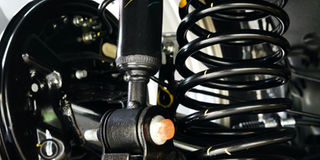How long do shock absorbers last?

As a motorist, you must pay attention to signs that your shocks are wearing out and have them replaced. NET PHOTO
Your car’s suspension system is made up of various components that work together to keep the car from bouncing around when driving over bumpy roads and one such component is the shock absorber.
These are usually located on both the front and rear wheels designed to take most of the hit when you are driving on uneven terrain, your shocks are constantly subjected to a lot of stress that may make them more likely to wear out faster. Now the question is, how long are they meant to last and when should you replace them?
There is no straight answer because it depends on several factors. The general rule of thumb sits at either five-10 years or 80,000 kilometres. But, it can be more or less depending on the conditions of the roads, a fact that we clearly see with the used car imports from Japan.
Sometimes, 15-year-old cars have perfectly fine shocks only to go bad within a year or two under the agitation presented by the roads here.
Signs
Instead of using time or mileage to decide when to replace shocks, use them as guides for when to have your entire suspension inspected for part wear, damage and leaks. The seals around their joints begin to wear off and the liquid or gas inside them leaks.
There are several tell-tell signs that your shocks have gone or are going bad. For instance when driving on rough, uneven roads becomes a nightmare due to the excessive jolting and bangs.
Also, if your car feels bouncy when going over humps, having more body lean in turns and nose diving when you brake just points to worn shock absorbers.
Habits
As motorists, there are things that we do that shorten the lifespan of our shocks. Driving over potholes, rough roads, and uneven terrain can cause a lot of added strain on your suspension system.
Of course, you cannot always choose where you drive, poor road conditions cannot be helped. So, if you have no choice but to drive on bumpy roads, try to minimise the damage by driving slower than you normally would.
Also, be conscious of potholes. If you see one in your path, try to avoid it as much as you can.
Heavy loads
Your car’s suspension system has a maximum load capacity, which refers to the total weight it can carry safely when on the road.
When you go past this limit, whether by having too many passengers on-board or carrying excessive cargo, you are overloading, a dangerous practice that can wreak havoc on your shocks.
Heavy loads can cause the springs in your suspension to distort or even crack from the strain which is cause for unsafe driving.
Replacement
Worn shocks do not just hamper driver comfort, they can harm overall suspension performance and reduce brake efficiency, cornering ability and antilock brake system effectiveness, aka your safety. So when shocks go bad, it is out with the old and in with the new.
Cult car spare part markets such as Kisekka and Ndeeba have an assortment of used shock absorbers.
While I would not recommend these, their cost is quite lucrative for many and they give a short-lived wave of life to the car’s suspension. As well, you can never know how much life is left in these as they are used so it is a hit and miss.
For some, the cost strongly justifies their use. That said, if you are to purchase shock absorbers, always go for brand new ones.




